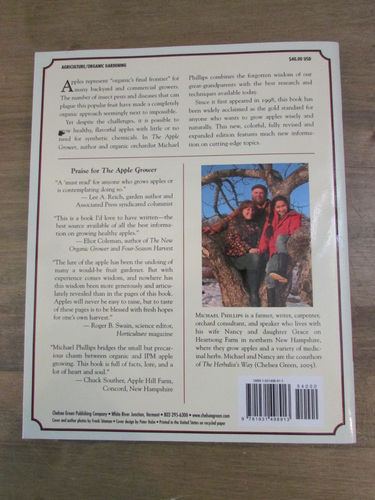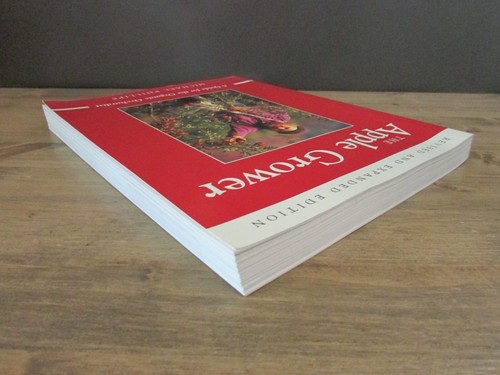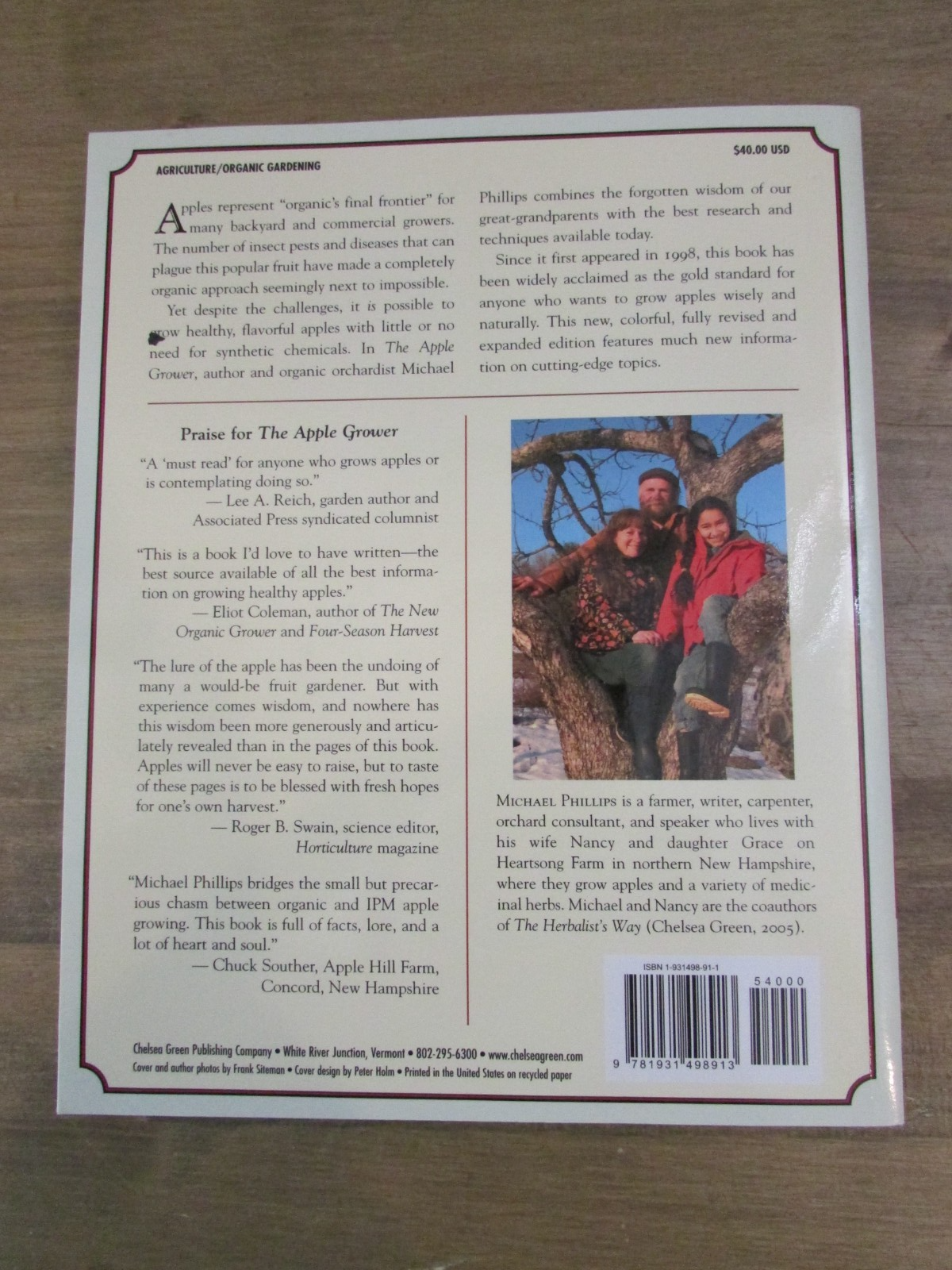
The Apple Grower: A Guide for the Organic Orchardist - Phillips, Michael
US $17.55US $17.55
Jul 24, 08:55Jul 24, 08:55
Picture 1 of 5





Gallery
Picture 1 of 5





Have one to sell?
The Apple Grower: A Guide for the Organic Orchardist - Phillips, Michael
US $17.55
ApproximatelyS$ 22.54
Was US $21.94 (20% off)
Condition:
Like New
A book in excellent condition. Cover is shiny and undamaged, and the dust jacket is included for hard covers. No missing or damaged pages, no creases or tears, and no underlining/highlighting of text or writing in the margins. May be very minimal identifying marks on the inside cover. Very minimal wear and tear.
Ended: Jul 24, 2025 08:55:10 SGT
Oops! Looks like we're having trouble connecting to our server.
Refresh your browser window to try again.
Shipping:
Free USPS Media MailTM.
Located in: Burnsville, Minnesota, United States
Delivery:
Estimated between Fri, 22 Aug and Tue, 26 Aug to 94104
Returns:
30 days return. Seller pays for return shipping.
Coverage:
Read item description or contact seller for details. See all detailsSee all details on coverage
(Not eligible for eBay purchase protection programmes)
Seller assumes all responsibility for this listing.
eBay item number:256938621560
Item specifics
- Condition
- ISBN
- 9781931498913
About this product
Product Identifiers
Publisher
Rizzoli International Publications, Incorporated
ISBN-10
1931498911
ISBN-13
9781931498913
eBay Product ID (ePID)
46601978
Product Key Features
Edition
2
Book Title
Apple Grower : Guide for the Organic Orchardist, 2nd Edition
Number of Pages
360 Pages
Language
English
Topic
Fruit, Organic
Publication Year
2005
Illustrator
Yes
Genre
Gardening
Format
Trade Paperback
Dimensions
Item Height
0.7 in
Item Weight
34.9 Oz
Item Length
10 in
Item Width
8 in
Additional Product Features
Intended Audience
Trade
LCCN
2005-022386
Reviews
Northern Woodlands (Review)- As anyone who has ever planted a few apple trees knows all too well, growing apples can be a perplexing and frustrating endeavor. The trouble is that apples are very attractive to many of nature's creatures besides humans. And at least one of these creatures, from deer to apple maggot flies, and from the roundheaded apple tree borer to mice (not to mention the long list of diseases that also affect apples), is sure to be working for its share of the fruit (and in some cases the tree) every day of the year. But if you've ever baked a pie made from your own apples, or pressed a batch of cider from them, the trials and tribulations all seem worth it with that first bite or sip. Michael Phillips' revised The Apple Grower has as much help as you'll find anywhere to get you to that first bite of pie or sip of cider. The previous edition, published in 1998, was the bible for many backyard orchardists and commercial organic growers. The new edition, boasting color photos and expanded and better-organized chapters, is a real treat for anyone interested in apples. The new edition's chapter on diseases and pests will be helpful to those left scratching their head about who or what is eating the apples or trees they are trying to grow. Phillips sprinkles tributes to other apple growers throughout the text. These persistent and dedicated souls, along with Phillips, are exploring uncharted territory: they are trying, without the use of traditional pesticides and chemicals, to keep ever-evolving pests and diseases away from trees that are themselves not evolving. All named apple varieties are genetic dead ends. A Macintosh today is genetically identical to a Macintosh from a century ago, but the bugs and diseases have spent that time evolving to break through the trees' defenses. Phillips presents intriguing ideas about orchard soils. Since people started growing apples in orchards, those orchard soils have largely been bacterially based, meaning that fertility has been maintained by the addition of bacteria-laden manure. Sheep and cattle were allowed to graze the grass and eat dropped apples, adding manure to the soils, and often the orchard was formerly pasture or hayfield, where manure was regularly added to maintain fertility. Bacteria-based soils are great for grasses and hay crops, but not necessarily for trees. Phillips argues that apple trees are still, well, trees, and like other trees, they prefer forest soils, which rely mainly on fungi to break down organic matter such as bark, wood, and other plant matter to maintain soil fertility. Phillips believes that this soil is what apple trees naturally want, and that it makes them healthier and better able to deal with pests and diseases. He has been experimenting with using fast-growing comfrey in his orchard, cutting it down to add rotting plant matter and to stifle the growth of grass, which can rob an apple tree's surface feeder roots of nutrients. He advocates adding composted branches, bark, wood chips, and even excess chunks of sheetrock to your orchard to promote the fungi in the soil and deter grasses. Phillips' style is more writerly than reference. His homespun stories about his many years of trying to outwit and outmaneuver the legions of apple-loving creatures are both entertaining and packed with tips. Phillips' extremely handy compendium of orchard tasks has always served as my basic plan of attack for what to do in my orchard, and the revised and expanded edition will be a welcome addition to my library. I have no doubt that over time it will take on the grimy, thumbed-through, and well-used look of my copy of the first edition of The Apple Grower., Northern Woodlands- "Michael Phillips' revised The Apple Grower has as much help as you'll find anywhere to get you to that first bite of pie or sip of cider. The previous edition, published in 1998, was the bible for many backyard orchardists and commercial organic growers. The new edition, boasting color photos and expanded and better-organized chapters, is a real treat for anyone interested in apples. The new edition's chapter on diseases and pests will be helpful to those left scratching their head about who or what is eating the apples or trees they are trying to grow. Phillips' style is more writerly than reference. His homespun stories about his many years of trying to outwit and outmaneuver the legions of apple-loving creatures are both entertaining and packed with tips. Phillips' extremely handy compendium of orchard tasks has always served as my basic plan of attack for what to do in my orchard, and the revised and expanded edition will be a welcome addition to my library. I have no doubt that over time it will take on the grimy, thumbed-through, and well-used look of my copy of the first edition of The Apple Grower.", "A must read for anyone who grows apples or is contemplating doing so."--Lee A. Reich, garden author and Associated Press syndicated columnist, "Mr. Phillips broke new ground with The Apple Grower . [It's] a book that defies the common belief that apples cannot be grown without chemical pesticides."-- New York Times "A must read for anyone who grows apples or is contemplating doing so."-- Lee A. Reich, garden author and Associated Press syndicated columnist "Michael Phillips' revised The Apple Grower has as much help as you'll find anywhere to get you to that first bite of pie or sip of cider. The previous edition, published in 1998, was the bible for many backyard orchardists and commercial organic growers. The new edition, boasting color photos and expanded and better-organized chapters, is a real treat for anyone interested in apples. The new edition's chapter on diseases and pests will be helpful to those left scratching their head about who or what is eating the apples or trees they are trying to grow. Phillips' style is more writerly than reference. His homespun stories about his many years of trying to outwit and outmaneuver the legions of apple-loving creatures are both entertaining and packed with tips. Phillips' extremely handy compendium of orchard tasks has always served as my basic plan of attack for what to do in my orchard, and the revised and expanded edition will be a welcome addition to my library. I have no doubt that over time it will take on the grimy, thumbed-through, and well-used look of my copy of the first edition of The Apple Grower ."-- Northern Woodlands
TitleLeading
The
Edition Description
Enlarged edition
Table Of Content
Acknowledgments Introduction Chapter One Growing Apples Locally Apple Growing a Hundred Years Ago Today's Integrated Pest Management Bringing It All Together Conventional Wisdom The Small Commercial Orchard in Context Chapter Two The Orchard Site and Its Climate Sacred Slopes The Four Points of the Compass Dry Ground Zone Hardiness Windbreaks Biodiversity in a Fruit Orchard Proximity to Markets Chapter Three The Enriching of Fruit Lands The Living Soil Compost Forever Soil Amendments Foliar Feeding Biodynamic Teachings Cover Cropping Ponderable Mulch Soil Tests and Leaf Analysis Trace Minerals for Every Tree Chapter Four The Trees and the Planting Cultivar Selection Rootstocks and Tree Spacing Nursery Sources and Varietal Collectors Grafting and Propagation The Setting of the Trees Orchard Size and Layout High-Density Plantings Down to the Nitty-Gritty Chapter Five Care of the Orchard Intuitive Pruning Training the Apple Tree Pollination and Fruit Set Frost Protection Thinning the Fruit The Great Grass Debate Mowing Options Summer Care Preparing for Winter Restoring Neglected Orchards Chapter Six Apple Pests and Diseases The Beginning of Understanding Good-bye, Foliar Pests Insect Identification Bug-by-Bug Profiles Beneficial Insects Good Sanitation Fungal Diseases Other Diseases of the Apple Four-Legged Considerations Chapter Seven Spraying for Balance The Complexities of Nature All the Answers Aren't Known, but We're Gaining Timing Is Everything The Orchard Calendar Botanicals, Elementals, and Forbidden Fruit Gentler Sprays Spray Equipment for the Small Commercial Orchard Matters of Concern Chapter Eight Reaping the Harvest When to Pick Harvest Equipment The Apple Picker's Reel Hiring Help Windfalls and Fat Sheep From Orchard to Packing Shed Grading Revisited Cider Making The Juice of the Apple Apple Storage Chapter Nine Marketing in the Local Economy Getting a Fair Price Apple Economics Niche Marketing Value-Added Products Organic Certification Advertising Marketing Innovations Long-Term Vision Chapter Ten The Last Organic Frontier The Sustainable Orchard Tree Spirit, Community Spirit Organic Perseverance Here We Come a-Wassailing Esopus Spitzenberg and a Better Tomorrow Appendix I Compendium of Orchard Tasks Appendix 2 Apple Grower's Source List Appendix 3 Lost Nation Apple Recipes Appendix 4 Bibliography Index
Synopsis
For decades fruit growers have sprayed their trees with toxic chemicals in an attempt to control a range of insect and fungal pests. Yet it is possible to grow apples responsibly, by applying the intuitive knowledge of our great-grandparents with the fruits of modern scientific research and innovation. Since The Apple Grower first appeared in 1998, orchardist Michael Phillips has continued his research with apples, which have been called "organic's final frontier." In this new edition of his widely acclaimed work, Phillips delves even deeper into the mysteries of growing good fruit with minimal inputs. Some of the cuttingedge topics he explores include: The use of kaolin clay as an effective strategy against curculio and borers, as well as its limitations Creating a diverse, healthy orchard ecosystem through understory management of plants, nutrients, and beneficial microorganisms How to make a small apple business viable by focusing on heritage and regional varieties, value-added products, and the "community orchard" model The author's personal voice and clear-eyed advice have already made The Apple Grower a classic among small-scale growers and home orchardists. In fact, anyone serious about succeeding with apples needs to have this updated edition on their bookshelf., For decades fruit growers have sprayed their trees with toxic chemicals in an attempt to control a range of insect and fungal pests. Yet it is possible to grow apples responsibly, by applying the intuitive knowledge of our great-grandparents with the fruits of modern scientific research and innovation. Since The Apple Grower first appeared in 1998, orchardist Michael Phillips has continued his research with apples, which have been called "organic's final frontier." In this new edition of his widely acclaimed work, Phillips delves even deeper into the mysteries of growing good fruit with minimal inputs. Some of the cutting-edge topics he explores include: The use of kaolin clay as an effective strategy against curculio and borers, as well as its limitations Creating a diverse, healthy orchard ecosystem through understory management of plants, nutrients, and beneficial microorganisms How to make a small apple business viable by focusing on heritage and regional varieties, value-added products, and the "community orchard" model The author's personal voice and clear-eyed advice have already made The Apple Grower a classic among small-scale growers and home orchardists. In fact, anyone serious about succeeding with apples needs to have this updated edition on their bookshelf.
LC Classification Number
SB363.2.U6
Item description from the seller
Seller feedback (1,310)
This item (1)
All items (1,310)
- y***a (16)- Feedback left by buyer.Past monthVerified purchaseExcellent book. Helped me with a perfect apple pie recipe in the back.
- s***t (42)- Feedback left by buyer.Past monthVerified purchaseWell packed, on-time, as described - pristine
- i***m (472)- Feedback left by buyer.Past monthVerified purchaseExcellent seller. Great communication. I had had an issue and it was resolved immediately. I would definitely recommend.
- 3***1 (937)- Feedback left by buyer.Past monthVerified purchaseGreat book in great shape! Fast shipping! AAAAAAA++++

